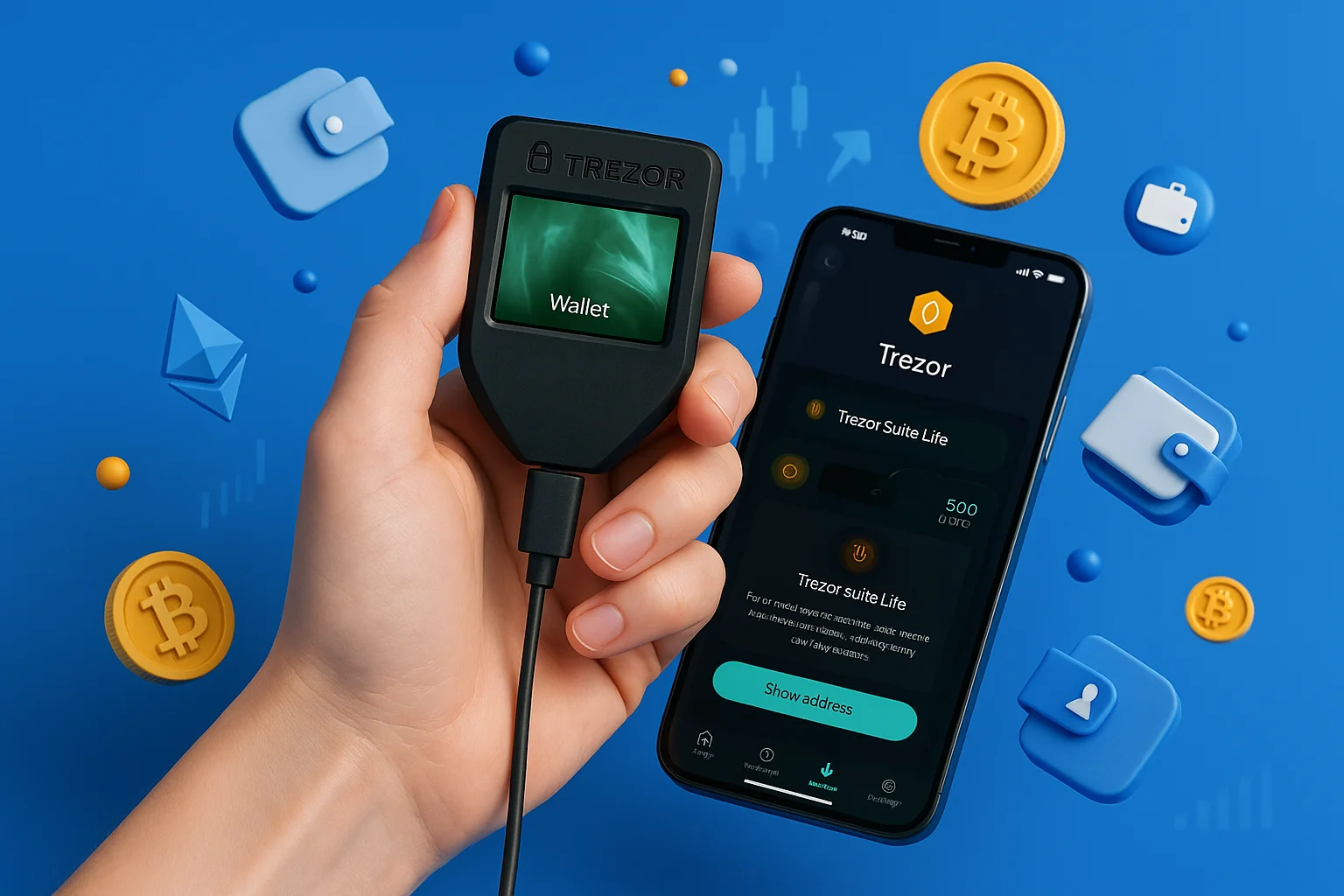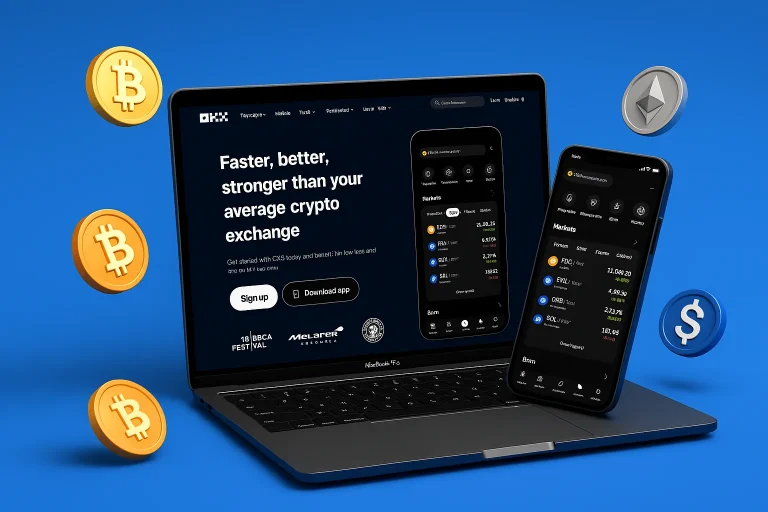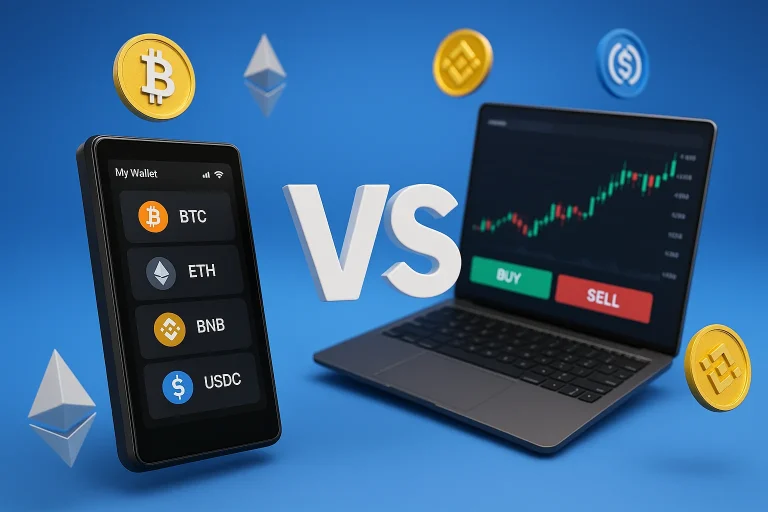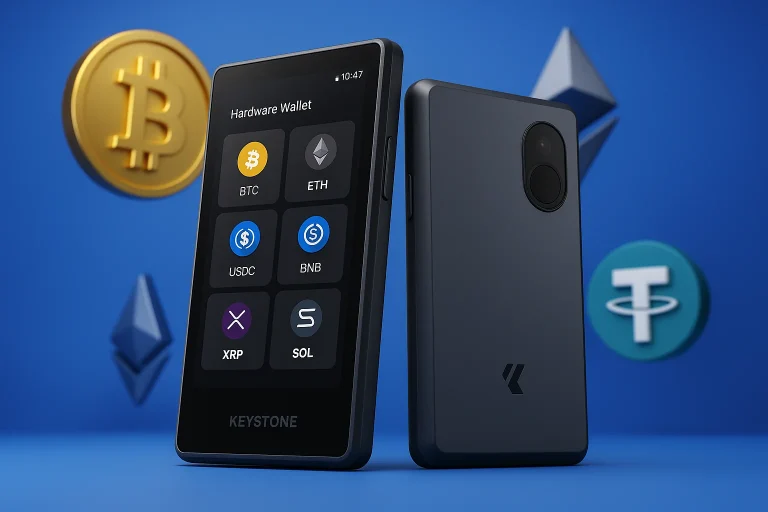You know how unsafe it is to store cryptocurrencies like Bitcoin and Ethereum in software wallets, right? We need a secure place to stash our digital treasures, and that’s where the Trezor Model T comes in.
Back in the early days, the Trezor Model One changed everything. It was the first hardware cryptocurrency wallet that gave users offline control over their private keys. However, time moves quickly in the crypto world, and as threats evolve, so do expectations. The Model T steps in with major improvements.
In this Trezor Model T review, we’ll break down everything you need to know, from security and usability to pricing and real-world performance. Whether you’re upgrading from a Model One or buying your new wallet, this article will show you exactly why the Trezor wallet Model T stands out.
Table of contents
Trezor Model T Specifications |
|
|---|---|
| Connectivity | USB-C (wired only) |
| Compatibility | Windows, macOS, Linux, Android (via USB-C) |
| Secure Chip | None (uses general-purpose MCU; security via open design and SD-Protect) |
| Display | Full-color LCD, capacitive touchscreen (240 × 240 px) |
| Microcontroller | ARM Cortex-M4 processor @ 168 MHz |
| Authentication | PIN code, optional passphrase, SD-Protect, two-factor authentication (2FA) |
| Recovery Backup | 12-, 18-, or 24-word recovery seed, Shamir Backup (SLIP39) |
| Privacy Features | Coin control, Tor support via Trezor Suite, hidden wallets via passphrase |
| Security Model | Open-source firmware and hardware, community-audited, SD-Protect support |
| Certifications | CE and RoHS certified, safe for air travel |
What is Trezor Model T?
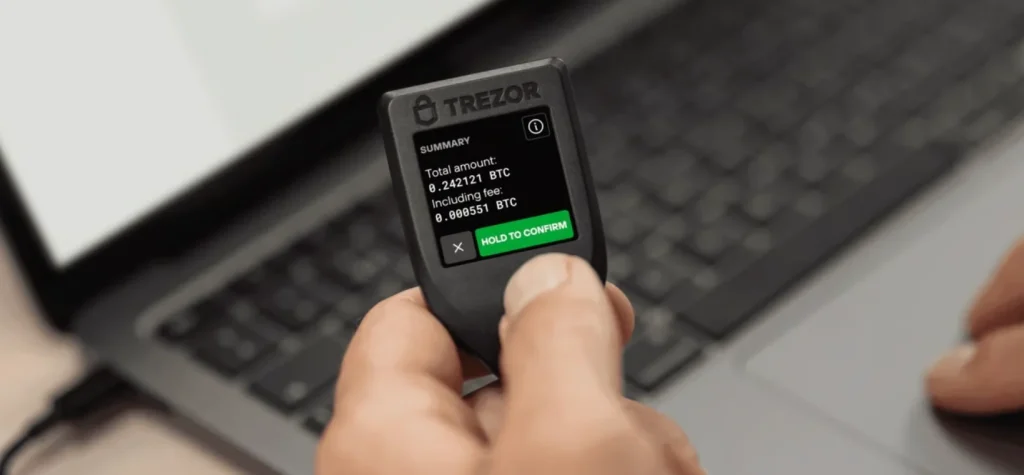
The Trezor Model T is a second-generation hardware wallet created by SatoshiLabs. It was launched in 2018 in direct response to user demands for better usability, broader asset support, and stronger security options compared to the first cryptocurrency hardware wallet, Trezor Model One.
While the Model One introduced the world to offline private key storage, many users wanted more: from managing complex coins like Cardano (ADA) and XRP, to managing crypto transactions through a modern, intuitive interface.
The Model T features a full-color touchscreen, native support for hundreds of additional crypto assets, and advanced features such as Shamir Backup and SD-Protect, all accessible via a built-in microSD card slot.
Users also requested better passphrase input, simplified navigation, and on-device verification. The Model T addressed all these, improving the entire experience without compromising the core principles of transparency and open-source firmware.
Today, the Trezor Model T remains one of the most advanced and trusted crypto hardware wallets. It integrates seamlessly with the Trezor Suite app, supports third-party wallets, and continues to evolve through frequent firmware updates.
For users who want more control, more assets, and more security, Trezor listened, and the Model T answered.
Trezor Model T: Security Review

1. Open Hardware and Secure Firmware
The Trezor Model T uses a general-purpose ARM Cortex-M4 processor and does not include a secure element chip. This is a deliberate design choice by Trezor, allowing for complete transparency across the hardware design and open-source firmware. The firmware is fully auditable by the crypto community and must be installed manually during the entire setup process.
Each time the device boots, it verifies the firmware’s authenticity using digital signatures from SatoshiLabs. If tampering is detected, the operation is halted. This model fosters trust and continuous improvement, thereby avoiding reliance on closed-source components commonly used in other hardware wallets.
However, the absence of a secure element is a common point of criticism. Some users believe this exposes the Model T to a higher risk in case of physical access attacks. While the firmware ensures integrity, hardware-level protections in SE-enabled wallets may offer better resistance to sophisticated tampering in some threat models.
2. Isolated Private Key Management
All cryptographic processes (including seed generation, address derivation, and transaction signing) occur entirely within the Trezor device. Private keys are never left in the secure environment. The only data sent through the USB-C connection is signed transaction information, which prevents host malware from accessing or leaking key material.
By excluding wireless technologies like Bluetooth or Wi-Fi, the Model T reduces potential entry points for remote attacks, reinforcing its position as a secure crypto hardware wallet.
That said, the lack of mobile-first features may be inconvenient for users looking for more flexible mobile support, especially those using iOS.
3. Recovery and Passphrase Protection
The Model T supports standard BIP39 recovery seeds (12, 18, or 24 words) and includes Shamir Backup (SLIP39), allowing users to split the seed into multiple shares for distributed storage. This provides an advanced level of redundancy and fault tolerance, making it ideal for long-term cryptocurrency storage.
A built-in passphrase protection feature enables the creation of a hidden wallet using the exact seed phrase. This extra layer of crypto security provides plausible deniability and minimizes the risk of forced access.
4. PIN Code and SD-Protect Integration
The Model T uses a customizable PIN code to restrict access. The interface is randomized for added protection, and after 16 incorrect entries, the device erases all sensitive data. To further enhance defense against physical access, the device supports SD-Protect using the built-in microSD card slot.
SD-Protect binds the device to a high-entropy secret stored on the microSD card when enabled. Both the PIN and the card are required to unlock the wallet. This provides strong protection in case of theft, as the device becomes useless without the specific card.
It’s worth noting, however, that SD-Protect is optional and must be manually configured. If not set up, the user relies solely on the PIN. Additionally, losing the microSD card does not permanently lock users out, as recovery is still possible using the recovery phrase.
5. Touchscreen-Based Transaction Verification
The Model T features a 1.54-inch, full-color touch screen with a 240 × 240 pixel resolution. This display enables secure on-device confirmation of addresses, fees, and transaction data. All sensitive operations must be explicitly approved via the screen, preventing silent manipulation by infected host systems.
The touchscreen is a significant upgrade over the button-based interface of the Trezor Model One, enhancing the user experience. However, the screen size may still feel small for entering long passphrases or reviewing complex data, especially for users with accessibility needs.
6. Firmware Updates and Ecosystem Support
Firmware updates are delivered exclusively via the Trezor Suite app and must be verified before installation. This ensures that only authenticated code is allowed to run. Updates typically include enhanced security features, improved asset support, and UI refinements.
The Model T seamlessly integrates with Trezor Suite, providing a secure and unified environment for managing crypto wallets. It also supports third-party wallets, such as MetaMask and Electrum, allowing for greater flexibility in cryptocurrency management.
While the ecosystem is robust, it lacks iOS support for full functionality. Mobile integration is primarily limited to Android devices, which require a USB-C cable. This may be a limitation for users who want seamless cross-device use.
Trezor Model T: Supported Assets
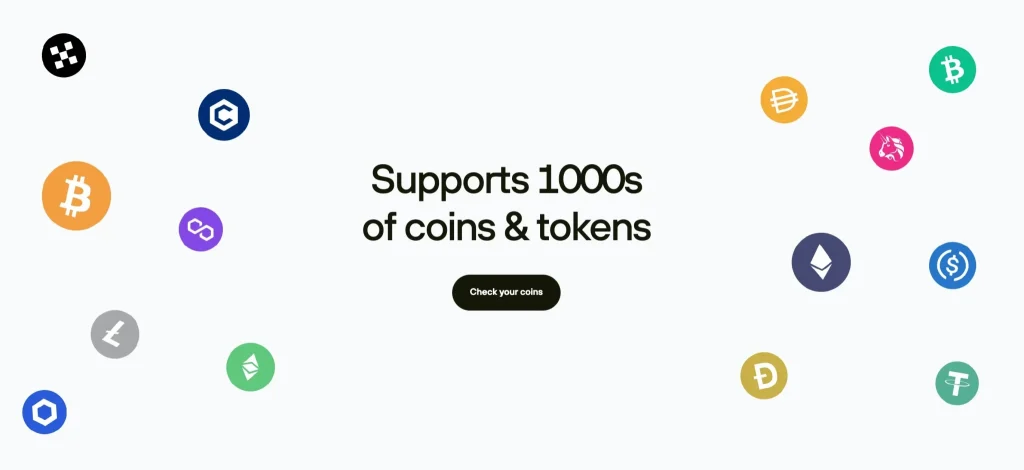
The Trezor Model T supports over 1,450 coins and tokens, making it one of the most versatile cryptocurrency hardware wallets. It includes native support for top crypto assets such as Bitcoin (BTC), Ethereum (ETH), Cardano (ADA), Ripple (XRP), Litecoin (LTC), Monero (XMR), Polkadot (DOT), and EOS.
Through the Trezor Suite or integration with third-party wallets like MetaMask and Electrum, users can also manage thousands of ERC‑20 tokens and other blockchain assets.
Unlike the Model One, the Trezor Model T offers native support for advanced protocols, including Cardano staking, Monero’s privacy features, and XRP’s unique transaction mechanics. This extended compatibility provides users with access to a broader spectrum of digital assets and ecosystems, allowing them to interact directly through the Trezor Suite app or other tools that support the device.
Notably, the Trezor Model T also offers NFT viewing and interaction via third-party DApps and wallets. While NFTs are not yet directly managed in Trezor Suite, the Model T can securely sign transactions involving NFTs, DeFi protocols, and more, making it a strong choice for those actively involved in the cryptocurrency space.
Trezor Model T Review: UI/UX
Like all Trezor hardware wallets, the Model T uses the same core interface: the Trezor Suite app. The UI is consistent across models and provides a unified environment for managing crypto wallets, updating firmware, accessing privacy features like coin control and Tor, and tracking supported coins.
What sets the Model T apart is its on-device interaction. Instead of buttons, it features a 1.54-inch color touch screen, improving interaction speed and clarity. Users can enter PIN codes, confirm transactions, and review addresses directly on the device. The display’s size and resolution (240 × 240 px) enhance visibility for longer data strings, making the recovery process and passphrase protection entry easier and more secure.
The interface remains clean and functional, offering basic personalization options without visual clutter. While minimal, the user interface gains from the added display space and touch functionality, especially compared to models that rely on physical buttons.
Trezor Model T Usability
The Trezor Model T supports Windows (10+), macOS (10.11+), Linux, and Android. It connects via a USB-C port, making it compatible with modern laptops and most Android phones.
The Trezor Suite is available in over 20 languages and auto-detects system language during installation. Manual language switching is available through the settings menu.
While the Model T lacks Bluetooth, it supports mobile use through wired connections. iOS support remains limited due to the absence of Lightning or Bluetooth connectivity, which affects compatibility with iPhones or iPads.
Onboarding is straightforward, even for first-time users. The setup flow walks users through creating a PIN code, backing up the recovery phrase, and optionally activating passphrase protection. The color touchscreen streamlines interactions, especially when entering complex data, approving crypto transactions, or labeling a new wallet.
The Model T integrates fully with Trezor Suite and is also compatible with third-party wallets like MetaMask, Electrum, and Exodus. Users can also use the device to purchase crypto or monitor asset performance through the Suite’s dashboard.
Support is provided via the Trezor support team, with options including help articles, ticket submissions, and access to paid 1:1 onboarding sessions. While live chat is not available, responses are typically fast and detailed.
Trezor Model T: Pricing
The current pricing makes the Trezor Model T one of the most competitively priced hardware wallets in the industry, considering its feature set.
Compared to the Ledger Nano X (~$149), which includes Bluetooth and a secure element, the Model T trades wireless connectivity for a more transparent design. While it lacks Bluetooth, it supports mobile use via USB-C port and works well with any Android phone.
Cheaper wallets, such as the Trezor Model One or software wallets, can be less expensive, but they often lack key security features and broader asset support.
The Model T is ideal for users who want a new wallet with better protection, reliable firmware updates, and strong support from the Trezor support team.
How to Set Up Trezor Model T
- Connect the Trezor Model T to your computer using the included USB-C cable.
- Go to trezor.io/start on your browser. Use Chrome or Firefox to ensure the best compatibility with Trezor Suite.
- Select “Trezor Model T” as your device and follow the prompts.
- Download and install the Trezor Bridge if prompted, then refresh the page.
- The device guides you through the entire setup process using its full-color touchscreen and intuitive user interface.
- Create a PIN code to protect your wallet. This PIN protects against physical access and unauthorized use.
- Back up your recovery seed, a 12-, 18-, or 24-word phrase that can restore your hardware wallet if it is lost or damaged.
- Optional: Enable passphrase protection to create a hidden wallet, or label your new wallet for easier cryptocurrency management.
The setup process is designed to be simple, enabling users to activate powerful security features. You can access help through the Trezor support team via the Suite interface if needed.
Pros and Cons of Trezor Model T Cryptocurrency Hardware Wallet
FAQ
The Trezor Model T utilizes offline private key storage, a secure hardware design, and robust security features, including PIN and passphrase protection. It is challenging to hack without physical access to your device and access to your recovery seed.
You can recover your crypto assets on any compatible hardware wallet using the 12-, 18-, or 24-word recovery seed. This process is done securely via the Trezor Suite app or supported third-party wallets.
Yes, the Trezor Model T is a highly trusted Bitcoin wallet and cryptocurrency hardware wallet. It keeps your private keys completely offline and secures your digital assets from malware, phishing, and remote attacks.
Both are leaders in the hardware wallet market, but the Trezor Model T offers open-source firmware, a color touch screen, and an optional microSD card slot for added security. It’s the first hardware wallet brand and remains a favorite in the crypto community.
Yes. With the Trezor Suite, you can sign and send crypto transactions from your Trezor device. While it doesn’t hold funds, it controls access to your crypto wallets by securely managing your private keys.
The microSD card slot enables SD-Protect, which binds the Trezor device to the card, adding an extra layer of security for unlocking the wallet and approving sensitive operations. It does not store crypto wallets or keys directly.
Buying from Amazon is risky unless it’s from Trezor Official or a certified reseller. Purchasing your new Trezor device directly from the official website is recommended for secure firmware pre-installation and warranty coverage.
Purchase the Trezor Model T from the official Trezor website or verified partners to ensure secure cryptocurrency storage. This guarantees authentic Trezor hardware wallets with official Trezor support, warranty, and genuine firmware.
Final Verdict: Yay & Nay?
The Trezor Model T is a significant upgrade from the original Model One, offering a color touchscreen, broader asset support, and advanced features such as Shamir Backup, SD-Protect, and passphrase protection.
At $129, it delivers excellent value, combining usability, transparency, and open-source security. While it lacks Bluetooth and a secure element, its consistent firmware updates and durable USB-C design make it a top choice for anyone seeking a reliable, non-custodial hardware wallet.
If you’re upgrading from a Model One or buying your first device, the Trezor Model T is the one to get.

